Cinco de Mayo Falco
![]()
Cinco de Mayo Falco |
|
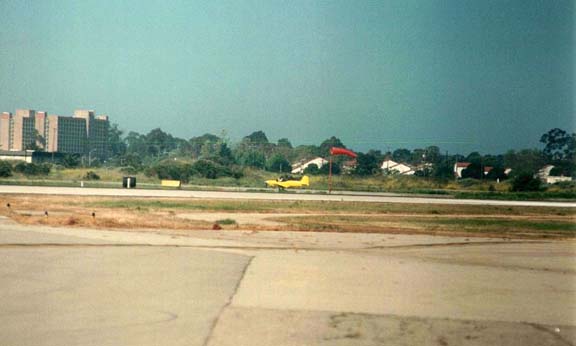
First takeoff run
Pierre did spend a lot of time in the run-up area to make sure that everything was okay with all of the power systems before taking the active runway. My excitement by this time was very evident to everyone around me. This was my baby that had taken twelve and a half years to deliver. Would it fly? Would it hold together? Would the engine continue to run well during the duration of the flight? Would Pierre have to cut the first flight short because of a mechanical problem? And what about all of the glue joints that held everything together to form one harmonous structure? Would they be able to handle the load and stress needed for flight?
All of these thoughts were racing though my mind as Pierre took the active runway and started his takeoff roll. Suddenly he, and my Falco, were airborne. We all started clapping, and I was jumping for joy. Here, after all these years, was the day that all of the hard work and dedication paid off. It was really flying! We watched as Pierre continued to climb and then he turned southeast, a route that would take him over the shoreline and the Pacific ocean. We finally lost sight of him as he gained altitude, and we headed back to the hangar to try to hear him on the departure frequency with the aircraft scanner we had brought along. Then the waiting started. [It's not like I just went out to sea. The area is rather built up, so I had to do a 45 degree upwind to avoid populated areas, then turned inland once I had 1500 feet. Bob and his group had lost sight of me by then, but I never actually got off shore. Believe me, I wanted the airport close by, just in case! -- Pierre]
Santa Barbara is Class B airspace and has two separate arrival and departure frequencies, one for the East and one for the West. As we switched back and forth between the two we listened intently for any communication from a Falco or an Experimental aircraft. We heard nothing until about forty minutes later when we heard Pierre requesting landing instructions. I think that the waiting and the suspense of not knowing how Pierre was doing was the worst part of the whole first flight.
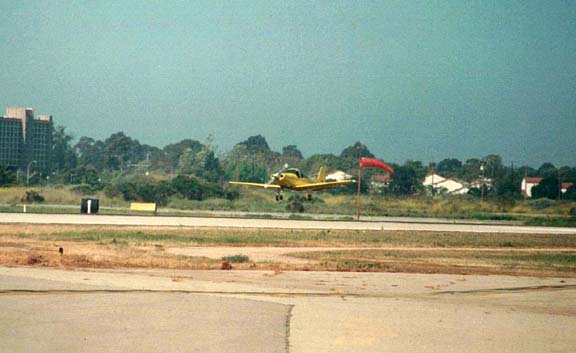
Breaks ground
Ken wanted a few pictures of the landing, so we hopped in his pickup truck and headed over to the arrival end the designated runway. Within a few minutes Pierre was over the fence although a bit high on final, and it looked like he had the full, 45 degrees of flaps deployed. Touchdown was long but uneventful and as we waited for Pierre to taxi back a sense of relief came over me. Pierre was back, safe and sound, and so was the Falco. As he turned off the taxiway and headed for us he gave us the thumbs-up sign signifying a good flight. I must say that he looked liked he had enjoyed the flight.
After the congratulations, Pierre put me in the left seat for my first flight and to get a feel for how the Falco handles compared to other types of airplanes. I had no problem in over controlling the Falco. It is very sensitive to any and all control inputs. Two or three fingers on the stick are definitely all that is needed for control. You caress a Falco instead of flying one.
We did a some stalls and slow flight and then took some time flying her for the pure enjoyment. The stalls were quite sharp and it always dropped the left wing. The stalls were somewhat frightening to me, and I have to chalk that up to the lack of current flight time in high performance aircraft. On that second flight Pierre did most of the flying, and I was the passenger. We planned to make a third flight later that afternoon after a well deserved break and lunch, and I would be doing the flying.
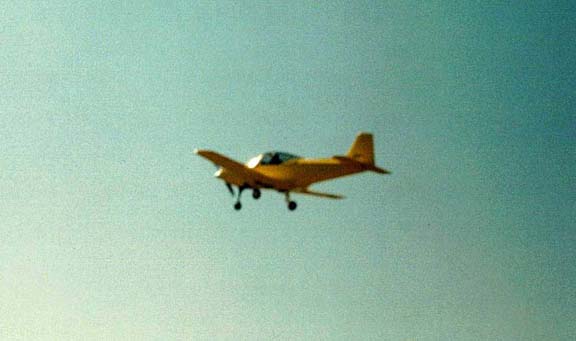
She flies
My second flight was a little better than the first. Shaky on the takeoff, I still over controlled and had a problem keeping the altitude within 100 feet. Other than that I was feeling a bit more comfortable at the controls. This flight was meant to be a "getting to know your airplane" flight and that is what we did. Tooling around the sky in a bright yellow, brand new Falco, what a thrill. We kept the flight to an hour and brought it home for the day. All in all we had a great first flight day with a lot of memories and a lot of excitement.
After the three flights there were a few problems that we needed to address before the next flight. An errant fuel pressure gauge, heavy right wing and an intercom that, because of the noise, was breaking the squelch. That was it. We did test the landing gear retraction system on the second and third flights, and it worked fine.
With the total of two flights I had accumulated 2.1 hours in a Falco. I still needed an additional 2.9 hours before I could solo and be covered with insurance. I knew that it would take some additional instruction, not just another 2.9 hours, before I felt that I was competent enough to solo. Pierre agreed to return in two weeks for another series of flights and possibly give me enough dual instruction to be able to solo. He had also suggested that a backup plan of action should be formed just in case he was unable to make the second trip and/or weather did not co-operate. He suggested that if I could arrange to fly with John Harns in Idaho, it would not only give me the opportunity to fly another Falco but Pierre had said that John was the smoothest Falco pilot he had flown with. Even if I was able to get checked out with Pierre, flying with John would be a great experience and well worth the effort and the expense. John is also an CFII so the time would be logged as dual received and he could sign me off to solo a Falco if Pierre and I didn't fly. Plans were made to fly up to John's home in Post Falls. John said he would be glad to have me come up, and he had a couple of days during the Memorial Day weekend that we could fly.
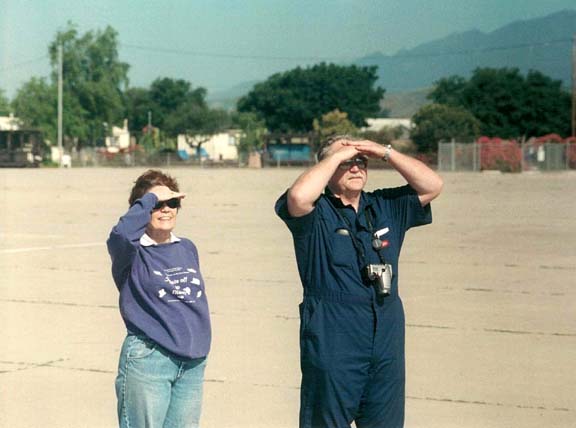
Janet and Bob Brantley watch the first flight.
The weather patterns around here are such that most of the spring we are shrouded under a marine layer, 600 feet overcast with the tops around three thousand feet. You need to be instrument rated just to be able to depart and go elsewhere. The order of the day is IFR to VFR on top. On Pierre's second trip down that's the type of weather we had to contend with. Weather forecasts were for overcast skies in the morning clearing to partially cloudy in the afternoon. Our plan was to head up to Santa Maria for some pattern work and then work on stalls if weather permitted. When Pierre arrived we were at 1200' overcast and low clouds. My good to go plan was to have at least a 1500' ceiling and if nothing else we could stay in close traffic at Santa Barbara and do the pattern work here. Things have a tendency not to go as planned as I'm sure you know.
After Pierre's plane was tied down, off we went for coffee, no break in the weather. Lunch time came and off for a leisurely lunch, still no break in the weather. Back to the airport around 1:30, and we had gained 100' to our ceiling, up to 1300' but by 2:30 it had dropped back down to 1200' and by 5:00 we were still under the marine layer. I hate to give up but both of us agreed that it would be better not to try flying this particular day. You do not want to be flying a new and yet unproven aircraft in IMC no matter what. It was a good thing that I would be heading up to see John Harns. If we hadn't arranged for a back-up plan in advance, I may have been in the hangar a lot longer.
I would like to say that John and his wife Pat are a couple of very gracious people. That is one thing that I have noticed about Falco builders. The whole clan is made up of friendly, "will do anything for you folks". I'm proud to be included in this fraternity, and I hope that I can live up to the challenge of being as helpful to other builders as I found John was to me. I was able to have five flights with John over the course of two days for a total of 4.7 hours.
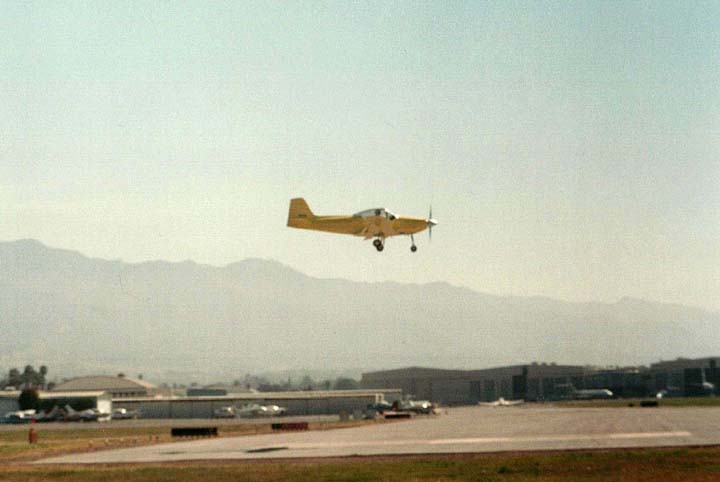
Approach for landing
This was some of the best flying I have ever been privilege to enjoy. John is an ex-navy carrier pilot and Pierre was right, he is smooth on the controls. If you ever get the chance to ride along with John, don't hesitate. The experience that I gained from his instruction was priceless and John was satisfied that I had enough expertise that he endorsed my log book for solo flight in a Falco. One bit of advice he did offer was to get a couple of hours in the pattern in a high performance airplane like a Bonanza to help ease the transition to flying the Falco. Good Advice.
I did solo 988RP on Memorial Day, and I was somewhat nervous before the flight. I remembered what John had said about flying a Bonanza but, not knowing someone local who had one, I was limited in what I could fly. Most of my recent time has been in an older Arrow and that wasn't what he meant when he suggested a high performance airplane. I made the decision to fly my own Falco after taking a serious look at the dual instruction that both Pierre and John had given me over the past couple of weeks. I wanted the skills that I had learned with them to be fresh in my mind when it was time for that solo ride. I also took a long time on that Monday with the pre-flight and not until everything was ready, including myself, did I climb aboard for that first flight.
As I look back to that flight, it was uneventful even if every bump from an air current caused concern and thoughts of "will the airplane stay glued together?". Fear can be a good emotion at times, it keeps the adrenaline levels increased, and it keeps you ready for action if the need arises. Lucky for me, nothing out of the ordinary was called for. The Falco flew fine and I enjoyed the moment of being one with something that was created with my talents and craftsmanship, a good feeling indeed. I hope to have all of the 25 required hours flown off by the time you receive this issue. Weather permitting, I will.
If you're building, keep up the progress. If you need help, find a Falco pilot close to you who can give you a hand. You don't have to do everything by yourself. The ones that have finished their projects are a gold-mine of information and are willing to pass it on.
Don't get discouraged and don't give up, remember that you need to look only at the part you are working on and not the whole project. With enough of those small parts assembled some day you too will have your own Falco. It is well worth the effort. Then you will be able to join the ranks of flying Falco builders, and you will have an airplane that is truly one of a kind.
We are planning to be in Texas for the next West Coast Falco Fly-in for a short visit anyway, since we don't have rooms reserved. Oshkosh is planned for 2002 but not this year because of our move to the Ozarks. Hope to see you there.
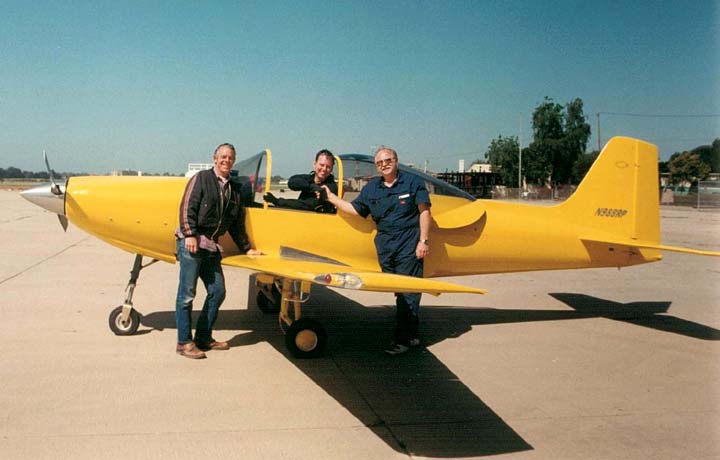
May 5, 2001. Ken Davids, Pierre Wildman and Bob Brantley after
the first flight.
|
|